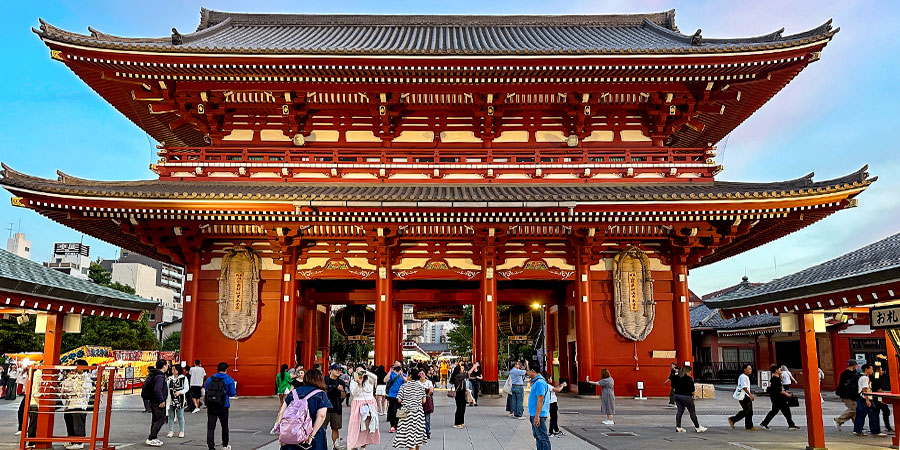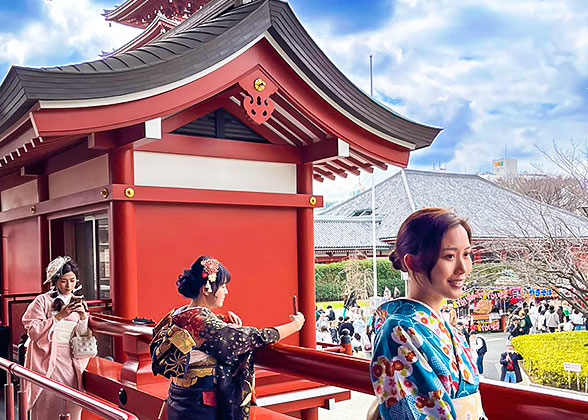Senso-ji Temple
History Rooted in a Legend
As the story goes, two brothers went for fishing on the Sumida River in 628 AD. They get a small statue of Kannon, the Japanese name of Avalokitesvara Bodhisattva – a Buddhist divine being, from the river. They thought the statue was useless for them, so they threw it into the flowing water. However, the statue drifted back to them. They threw it dozens of times, but the statue came back to them every time. Thus, they felt so magical that built a temple on the riverbank to worship Kannon. That was just Senso-ji Temple.

Senso-ji Temple Photos ( 39
|
After multiple damages and repairs, Senso-ji Temple ushered in a massive reconstruction in early Edo era (1603-1868 AD). Tokugawa Ieyasu, the shogun at that time, designated the temple as the prayer house of his shogunate. Thence, it became a large temple and has attracted numerous pilgrims and visitors.
Major Attractions/Things to Do in Senso-ji Temple
Kaminarimon (Thunder Gate)
When you comes to Asakusa, Kaminarimon, the thunder gate in Japanese, is a must-see landmark. It’s the outside entrance to Senso-ji Temple, a typical old gate built to pray for peace and good harvests in the 10th century. The giant red lantern hanged in the center is very eye-catching, with Japanese word “Thunder Gate” written on. On the left is the statue of the god of wind, while on the right is the statue of the god of thunder.
|
|
|
Nakamise-dori Street
Walking through the Kaminarimon, you will reach Nakamise-dōri, or called Nakamise Shopping Street, in the old style on the whole. The street was a cause way for pilgrims initially, to the modern time, many shops stand at the roadsides. You could see traditional small items and fine souvenirs there, and more alluringly, you can try the local snacks to your heart's content.
![]() Nakamise Shopping Street Photos
Nakamise Shopping Street Photos
Hozomon Gate
At the other end of Nakamise Shopping Street, that is the Hozomon Gate, which means the gate of treasures. It is the true gate of Senso-ji Temple. What’s interesting is that, there are two enormous straw sandals hanging on the back of Hozomon Gate, one on each side. These are really large, 3 meters (9.8 feet) long and 1 meter (3.3 feet) wide. The big straw sandals symbolize farming, which is a wish for a harvest of ancient Japanese.Five-Storied Pagoda
Five-Storied Pagoda, Goju-no-To in Japanese, is in the southwest corner of Senso-ji Temple. You can witness what a typical Japanese pagoda is like on the spot. About 48 meters (157 feet) high, it is the second highest pagoda in Japan. There is a Sarira, Buddha’s relic, from Sri Lanka has been preserved on the top.

Five-storied pagoda
|

Main Hall of Senso-ji Temple
|
Main Hall of Senso-ji Temple – Hondo
The main hall is the site where Kannon – Avalokitesvara Bodhisattva has been worshipped, also called Hondo or Kannondo Hall. The outer hall has a concrete floor, while the inner hall is covered with tatami and a niche of Kannon is placed. However, the statue of Kannon is on to public on some special days only. In addition to Buddhist statues, the mini Kannon statues that Edo shoguns and monastics as well as high-ranking imperial family members wore as protective talismans are also displayed.Asakusa Shrine
On the east side of the main hall, Asakusa Shrine is also a crucial site inside Senso-ji Temple. It is one of the influential shrines, dedicated to three persons who were closely related to the founding of Senso-ji Temple: the brothers who salvaged the statue on Sumida River and the scholar (might be a monk) who recognized the sculpture as a Bodhisattva statue. In May every year, bustling Sanja Matsuri is held here, attracting countless visitors for the festival.Fortune-Telling Paper Slips
Senso-ji Temple is hot for the fortune-telling as well. After dropping JPY 100, you can draw a fortune-telling stick by shaking the lot pot with a small hole on an end, and match the number on the stick and that on the drawers. In the corresponding drawer, you can find the Omikuji, fortune-telling paper slip. A propitious explanation is of course good, but the unsatisfactory paper slip can be tied to the special site in the temple, to avoid bringing bad luck home and pray for blessings.
|
|
|
Etiquette & Tips
1. Scoop the water with right hand and rinse your left hand;
2. Scoop the water with the left hand and rinse the right hand;
3. Scoop some water with the right hand, pour the water into your left palm to gargle
4. Clean the handle of ladle with the remaining water on your palm;
5. Put the ladle back in place.
Never send the water in the ladle directly to the mouth to gargle.
Temple Festivals/Events Can be Expected
![]() Sanja Matsuri is the grandest festival in Asakusa area and Tokyo in the third weekend in May. Asakusa Shrine in Senso-ji Temple is the major venue to hold the festival. People would have a parade through streets in clothes of Edo era, while lifting mikoshi, the holy sedan chairs for gods. You could also watch the Shinto ceremony and traditional dance performance to pray for blessings. Watch the official notice of celebration schedule, you may discover more interesting activities during Sanja Matsuri.
Sanja Matsuri is the grandest festival in Asakusa area and Tokyo in the third weekend in May. Asakusa Shrine in Senso-ji Temple is the major venue to hold the festival. People would have a parade through streets in clothes of Edo era, while lifting mikoshi, the holy sedan chairs for gods. You could also watch the Shinto ceremony and traditional dance performance to pray for blessings. Watch the official notice of celebration schedule, you may discover more interesting activities during Sanja Matsuri.
|
|
|

Hozomon Gate
|
![]() Samba Carnival, sounds not right in this historical site, is an exultant event indeed in Asakusa, near Senso-ji Temple. In late August each year, the carnival parade is highly likely to pass in front of Kaminarimon. What a surprise!
Samba Carnival, sounds not right in this historical site, is an exultant event indeed in Asakusa, near Senso-ji Temple. In late August each year, the carnival parade is highly likely to pass in front of Kaminarimon. What a surprise!
Opening Hours & Admission
Free entry to Senso-ji Temple|
Area |
Opening Hours |
|
Kaminarimon |
24 hours |
|
Nakamise Shopping Street |
Generally 09:00-19:00 Depending on the shopkeepers |
|
Senso-ji Temple area |
06:00-17:00 April to September 06:30-17:00 October to March |
|
Asakusa Shrine |
24 hours |
How to Get to Senso-ji Temple
1. The metro station of Asakusa can be reached by the Ginza Line of Tokyo Metro, Toei Asakusa Line, and Tobu Skytree Line. Senso-ji Temple is very close to Asakusa Station within a few minutes’ walk.2. The sightseeing ferry Tokyo Cruise is also available to Senso-ji Temple, as the pier is next to Asakusa station by Sumida River.
Take JR Chuo Line or Yamanote Line at Tokyo Station to Kanda, and transfer to Ginza Line of Tokyo Metro to Asakusa Station.
Take JR Chuo Line to Kanda, and transfer to Ginza Line to Asakusa station.
Take Toei Shinjuku Line to Higashi-nihombashi, and transfer to Asakusa Line to Asakusa station.
Senso-ji Temple Photos & more Tokyo Photos
Senso-ji Temple Videos




